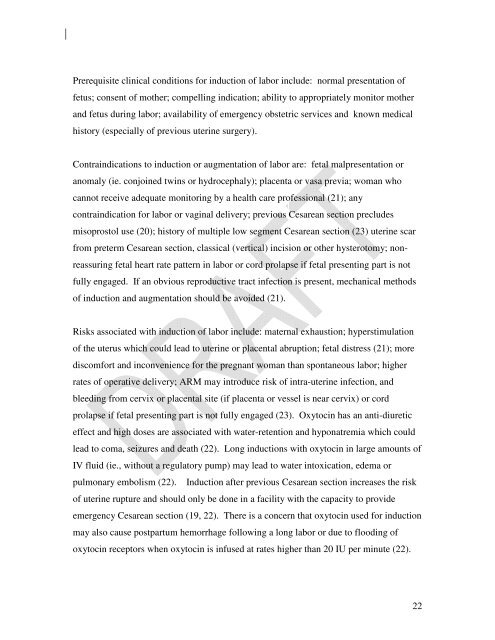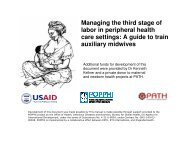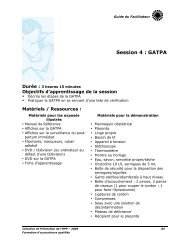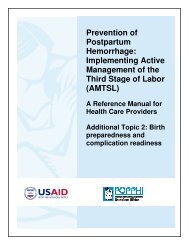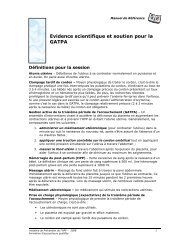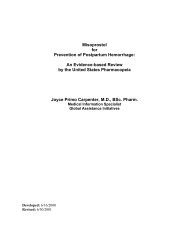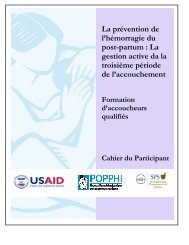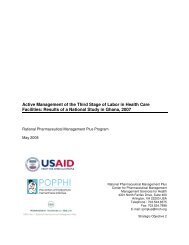Use of oxytocin and misoprostol for induction or ... - POPPHI
Use of oxytocin and misoprostol for induction or ... - POPPHI
Use of oxytocin and misoprostol for induction or ... - POPPHI
Create successful ePaper yourself
Turn your PDF publications into a flip-book with our unique Google optimized e-Paper software.
Prerequisite clinical conditions <strong>f<strong>or</strong></strong> <strong>induction</strong> <strong>of</strong> lab<strong>or</strong> include: n<strong>or</strong>mal presentation <strong>of</strong><br />
fetus; consent <strong>of</strong> mother; compelling indication; ability to appropriately monit<strong>or</strong> mother<br />
<strong>and</strong> fetus during lab<strong>or</strong>; availability <strong>of</strong> emergency obstetric services <strong>and</strong> known medical<br />
hist<strong>or</strong>y (especially <strong>of</strong> previous uterine surgery).<br />
Contraindications to <strong>induction</strong> <strong>or</strong> augmentation <strong>of</strong> lab<strong>or</strong> are: fetal malpresentation <strong>or</strong><br />
anomaly (ie. conjoined twins <strong>or</strong> hydrocephaly); placenta <strong>or</strong> vasa previa; woman who<br />
cannot receive adequate monit<strong>or</strong>ing by a health care pr<strong>of</strong>essional (21); any<br />
contraindication <strong>f<strong>or</strong></strong> lab<strong>or</strong> <strong>or</strong> vaginal delivery; previous Cesarean section precludes<br />
<strong>misoprostol</strong> use (20); hist<strong>or</strong>y <strong>of</strong> multiple low segment Cesarean section (23) uterine scar<br />
from preterm Cesarean section, classical (vertical) incision <strong>or</strong> other hysterotomy; nonreassuring<br />
fetal heart rate pattern in lab<strong>or</strong> <strong>or</strong> c<strong>or</strong>d prolapse if fetal presenting part is not<br />
fully engaged. If an obvious reproductive tract infection is present, mechanical methods<br />
<strong>of</strong> <strong>induction</strong> <strong>and</strong> augmentation should be avoided (21).<br />
Risks associated with <strong>induction</strong> <strong>of</strong> lab<strong>or</strong> include: maternal exhaustion; hyperstimulation<br />
<strong>of</strong> the uterus which could lead to uterine <strong>or</strong> placental abruption; fetal distress (21); m<strong>or</strong>e<br />
discom<strong>f<strong>or</strong></strong>t <strong>and</strong> inconvenience <strong>f<strong>or</strong></strong> the pregnant woman than spontaneous lab<strong>or</strong>; higher<br />
rates <strong>of</strong> operative delivery; ARM may introduce risk <strong>of</strong> intra-uterine infection, <strong>and</strong><br />
bleeding from cervix <strong>or</strong> placental site (if placenta <strong>or</strong> vessel is near cervix) <strong>or</strong> c<strong>or</strong>d<br />
prolapse if fetal presenting part is not fully engaged (23). Oxytocin has an anti-diuretic<br />
effect <strong>and</strong> high doses are associated with water-retention <strong>and</strong> hyponatremia which could<br />
lead to coma, seizures <strong>and</strong> death (22). Long <strong>induction</strong>s with <strong>oxytocin</strong> in large amounts <strong>of</strong><br />
IV fluid (ie., without a regulat<strong>or</strong>y pump) may lead to water intoxication, edema <strong>or</strong><br />
pulmonary embolism (22). Induction after previous Cesarean section increases the risk<br />
<strong>of</strong> uterine rupture <strong>and</strong> should only be done in a facility with the capacity to provide<br />
emergency Cesarean section (19, 22). There is a concern that <strong>oxytocin</strong> used <strong>f<strong>or</strong></strong> <strong>induction</strong><br />
may also cause postpartum hem<strong>or</strong>rhage following a long lab<strong>or</strong> <strong>or</strong> due to flooding <strong>of</strong><br />
<strong>oxytocin</strong> recept<strong>or</strong>s when <strong>oxytocin</strong> is infused at rates higher than 20 IU per minute (22).<br />
22


